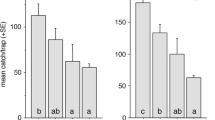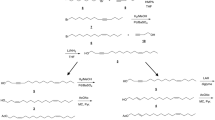Abstract
The sex pheromone communication of the lesser peachtree borer,Synanthedon pictipes (Grote and Robinson), and the peachtree borer,Sanninoidea exitiosa (Say), can be disrupted by permeation of the atmosphere with their respective sex pheromones, (E,Z)- and (Z,Z)-3,13-octadecadien-1-ol acetate. The two isomers seemed equally effective against both species. Disruption was greatest when the pheromone was evaporated from the tops of the peach trees; also, pheromone traps placed in the tree tops captured significantly more males than did traps placed lower in the trees. Neither the color nor the directional placement in a tree (NE, NW, SE, SW) of pheromone-baited traps influenced captures of male lesser peachtree borers.
Similar content being viewed by others
References
Antonio, A.Q., Mclaughlin, J.R., Leppla, N.C., andGreen, C.W. 1975. Culturing the lesser peachtree borer.J. Econ. Entomol. 68:309–310.
Birch, M.C. (ed). 1974. Pheromones. American Elsevier, New York, 495 pp.
Buriff, C.R., andDavis, D.G. 1974. A modified wing trap for capturing adult male lesser peachtree borers.Environ. Entomol. 3:191–192.
Hendricks, D.E., andLeal, M.P. 1973. Catch of adult tobacco budworm moths influenced by height of sex-lure traps.J. Econ. Entomol. 66:1218–1219.
McLaughlin, J.R., Shorey, H.H., Gaston, L.R., Kaae, R.S., andStewart, F.D. 1972. Sex pheromones of Lepidoptera. XXXI. Disruption of sex pheromone communication inPectinopliora gossypiella with hexalure.Environ. Entomol. 1:645–650.
Mitchell, E.R. 1975. Disruption of pheromonal communication among coexistant pest insects using multichemical formulations.BioScience 25:493–499.
Mitchell, E.R., Stanley, J.M., Webb, J.C., andBaumhover, A.H. 1974. Cylindrical electric grid traps: The influence of elevation, size, and electrode spacing on captures of male cabbage loopers and tobacco hornworms.Environ. Entomol. 3:49–50.
Nielsen, D.G., Purrington, F.F., Tumlinson, J.H., Doolittle, R.E. andYonce, C.E. 1975. Response of male clearwing moths to caged virgin females, female extracts, and synthetic sex attractants.Environ. Entomol. 4:451–454.
Saario, C.A., Shorey, H.H., andGaston, L.K. 1970. Sex pheromones of noctuid moths. XIX. Effect of environmental and seasonal factors on captures of males ofTrichoplusia ni in pheromone-baited traps.Ann. Entomol. Soc. Am. 63:667–672.
Sharma, R.K., Rice, R.E., Reynolds, H.T., andShorey, H.H. 1971. Seasonal influence and effect of trap location on catches of pink bollworm males in sticky traps baited with hexalure.Ann. Entomol. Soc. Am. 64:102–105.
Shorey, H.H., Kaae, R.S., Gaston, L.K., andMcLaughlin, 1972. Sex pheromones of Lepidoptera.XXX. Disruption of sex pheromone communication inTrichoplusia ni as a possible means of mating control.Environ. Entomol. 1:641–645.
Tumlinson, J.H., Yonce, C.E., Doolittle, R.E., Heath, R.R., Gentry, C.R., andMitchell, E.R. 1974. Sex pheromones and reproductive isolation of the lesser peachtree borer and the peachtree borer.Science 185:614–616.
Wong, T.T.Y., Kamasaki, H., Dolphin, R.E., Dave, D.G., Mouzin, T.E., Ralston, D.F., andBarnside, J.E. 1972. Mass trapping of male lesser peachtree borer moths with virgin female traps on Washington Island, Wis., 1970.J. Econ. Entomol. 65:1034–1039.
Author information
Authors and Affiliations
Additional information
Mention of a commercial or proprietary product in this paper does not constitute a recommendation or an endorsement of that product by the USDA.
Rights and permissions
About this article
Cite this article
Mclaughlin, J.R., Doolittle, R.E., Gentry, C.R. et al. Response to pheromone traps and disruption of pheromone communication in the lesser peachtree borer and the peachtree borer (Lepidoptera: Sesiidae). J Chem Ecol 2, 73–81 (1976). https://doi.org/10.1007/BF00988026
Received:
Revised:
Issue Date:
DOI: https://doi.org/10.1007/BF00988026




